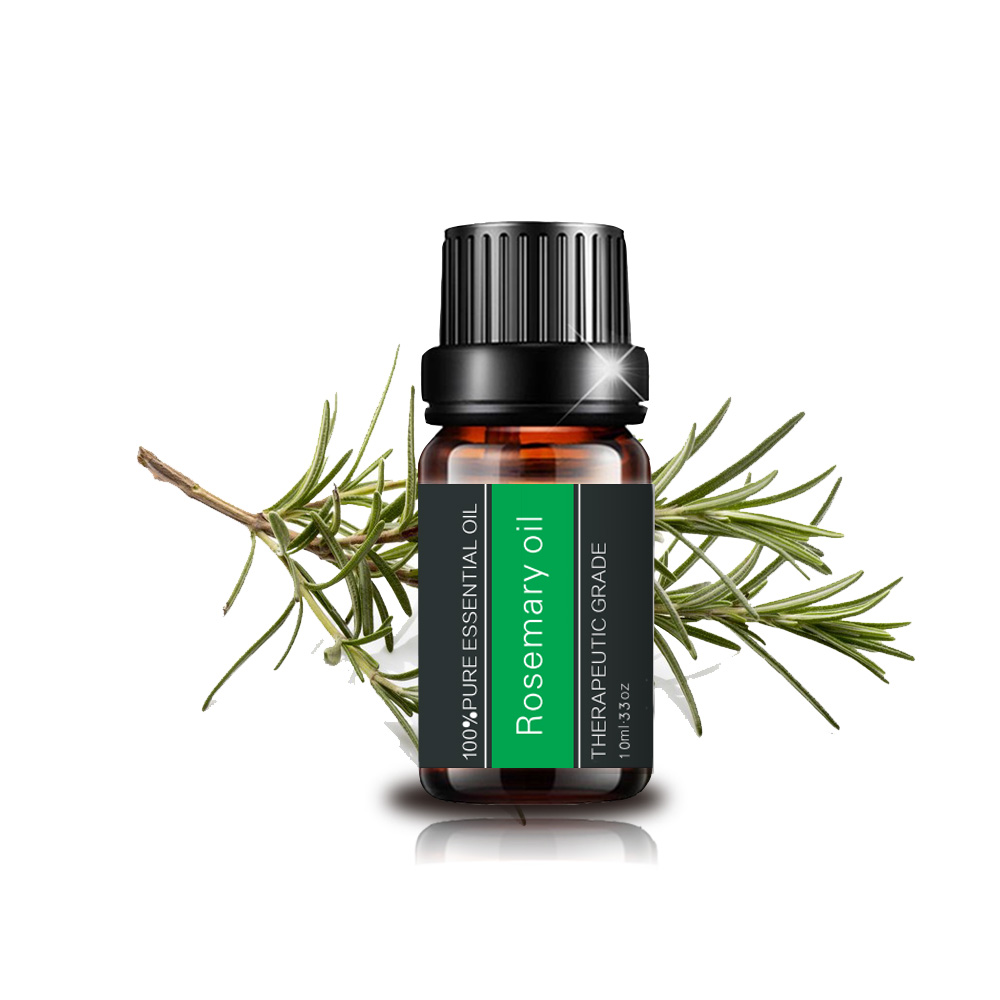BENEFITS OF ROSEMARY OIL
Rosemary Essential Oil’s chemical composition consists of the following main constituents: α -Pinene, Camphor, 1,8-Cineol, Camphene, Limonene, and Linalool.
Pinene is known to exhibit the following activity:
Camphor
- Cough suppressant
- Decongestant
- Febrifuge
- Anesthetic
- Antimicrobial
- Anti-inflammatory
1,8-Cineol
- Analgesic
- Anti-bacterial
- Anti-fungal
- Anti-inflammatory
- Anti-spasmodic
- Anti-viral
- Cough suppressant
Camphene
- Anti-oxidant
- Soothing
- Anti-inflammatory
Limonene
- Nervous system stimulant
- Psychostimulant
- Mood-balancing
- Appetite suppressant
- Detoxifying
Linalool
- Sedative
- Anti-inflammatory
- Anti-anxiety
- Analgesic
Used in aromatherapy, Rosemary Oil helps reduce stress levels and nervous tension, boost mental activity, encourage clarity and insight, relieve fatigue, and support respiratory function. It is used to improve alertness, eliminate negative moods, and increase the retention of information by enhancing concentration. The scent of Rosemary Essential Oil stimulates the appetite and is also known to reduce the level of harmful stress hormones that are released when involved in tense experiences. Inhaling Rosemary Oil boosts the immune system by stimulating internal anti-oxidant activity, which in turn fights ailments caused by free radicals, and it relieves throat and nasal congestion by clearing the respiratory tract.
Diluted and used topically, Rosemary Essential Oil is known to stimulate hair growth, reduce pain, soothe inflammation, eliminate headaches, strengthen the immune system, and condition hair to make it look and feel healthy. Used in a massage, Rosemary Oil’s detoxifying properties can facilitate healthy digestion, relieve flatulence, bloating and cramps, and relieve constipation. Through massage, this oil stimulates circulation, which allows the body to better absorb nutrients from food. In cosmetics for hair care, Rosemary Essential Oil’s tonic properties stimulate hair follicles to lengthen and strengthen hair while slowing the graying of hair, preventing hair loss, and moisturizing dry scalp to relieve dandruff. Traditionally, Rosemary Oil combined with Olive Oil in a hot oil hair treatment has been known to darken and strengthen hair. The anti-microbial, antiseptic, astringent, antioxidant, and tonic properties of this oil make it a beneficial additive in skin care products that are meant to soothe or even treat dry or oily skin, eczema, inflammation, and acne. Effective for all skin types, this rejuvenating oil can be added to soaps, face washes, face masks, toners, and creams to achieve firm yet hydrated skin that appears to have a healthy glow that is free of unwanted marks.
Rosemary Essential Oil’s refreshing and energizing aroma can be diluted with water and used in natural homemade room fresheners to eliminate unpleasant odors from the environment as well as from objects. When added to recipes for homemade scented candles, it can work the same way to freshen the scent of a room.
- COSMETIC: Stimulant, Analgesic, Anti-inflammatory, Antiseptic, Anti-fungal, Anti-bacterial, Astringent, Disinfectant, Antioxidant.
- ODOROUS: Anti-stress, Cognition-enhancement, Psycho-stimulant, Stimulant, Decongestant.
- MEDICINAL: Anti-bacterial, Anti-fungal, Detoxifying, Analgesic, Anti-inflammatory, Carminative, Laxative, Decongestant, Antiseptic, Disinfectant, Antiseptic, Anti-nociceptive.
CULTIVATING AND HARVESTING QUALITY ROSEMARY OIL
Rosemary is a perennial bush that often grows on the sea cliffs of Spain, France, Greece, and Italy. The leaves of the aromatic Rosemary bush have a high oil concentration, and it is part of an aromatic family of herbs, which also includes Lavender, Basil, Mint, and Oregano to name a few.
Rosemary is a hardy plant that can withstand frost, but it also loves the sun and thrives in dry climates where the temperature is between 20ᵒ-25ᵒ Celsius (68ᵒ-77ᵒ Fahrenheit) and does not drop below -17ᵒ Celsius (0ᵒ Fahrenheit). Though Rosemary can grow in a small pot inside a home, when grown outside, the Rosemary bush can reach a height of approximately 5 ft. Due to its adaptability to various ecological conditions, Rosemary plants can vary in appearance in terms of their colors, the sizes of their flowers, and the aromas of their essential oils. The Rosemary plant requires adequate water drainage, as it will not grow well if it is over irrigated or in soils with a high clay content, thus it can grow in the earth that ranges in soil type from sandy to clay loam soil as long as it has a pH range of 5,5 to 8,0.
The upper side of Rosemary leaves are dark and the undersides are pale and covered in thick hairs. The tips of the leaves begin to sprout small, tubular pale- to deep-blue flowers, which continue to bloom in the summer. Rosemary Essential Oil of the most superior quality is obtained from the flowering tops of the plant, although oils can also be obtained from the stems and leaves before the plant begins to flower. Rosemary fields are usually harvested once or twice a year, depending on the geographical region of cultivation. Harvesting is most often done mechanically, which allows more frequent cutting due to higher yields from rapid regrowth.
Before distillation, the leaves are dried either naturally by the heat of the sun or by using driers. Drying the leaves in the sun results in poor quality leaves for producing oils. The ideal drying method involves the use of a forced air-flow drier, which results in better quality leaves. After the product is dried, the leaves are further processed to have the stems removed. They are sieved to remove dirt.
NAME:Kelly
CALL:18170633915
WECHAT:18770633915
Post time: May-06-2023


